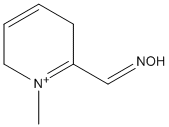pro-2PAM
General
Type : Oxime, Pyridine-aldoxime
Chemical_Nomenclature : N-methyl-1,6-dihydropyridine-2-carbaldoxime hydrochloride
Canonical SMILES : CN1CC=CC=C1C=NO.Cl
InChI : InChI=1S\/C7H10N2O.ClH\/c1-9-5-3-2-4-7(9)6-8-10\;\/h2-4,6,10H,5H2,1H3\;1H\/b8-6+\;
InChIKey : REIIOHUYMPSAPS-WVLIHFOGSA-N
Other name(s) : Pro-pam, 1-methyl-1,6-dihydropyridine-2-carbaldoxime
MW : 174.628
Formula : C7H11ClN2O
CAS_number :
CID PubChem :
InChIKey UniChem :
Iuphar :
Wikipedia :

Target
Structure : No structure
Families : No family
References
No reference